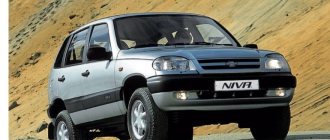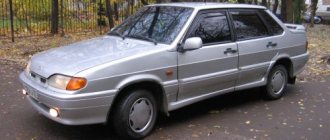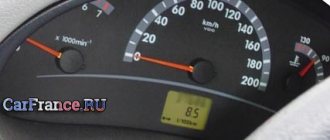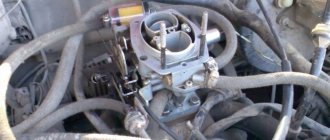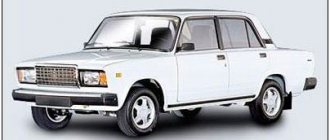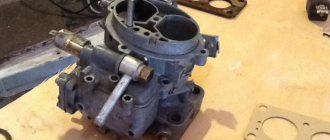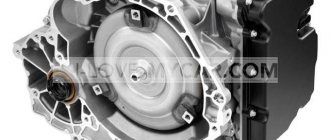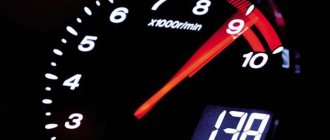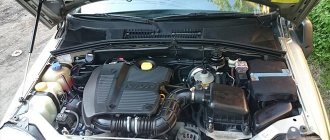The 1.8-liter Opel engine has the best performance. With a power of 125 horsepower per 100 kilometers, it consumes:
- 12.7 liters in the city;
- 8.4 liters on the highway;
- 10.3 liters in the combined cycle.
Engines with a volume of 1.7 liters produced by AvtoVAZ are distinguished by higher consumption and lower power. The 82-horsepower Euro-5 engine consumes:
- 14.1 liters in the city;
- 8.8 liters on the highway;
- 11.2 liters in the combined cycle.
The outdated 1.7 liter engine model, which meets the Euro-2 environmental standard, consumes slightly less - 10.8 l/100 km in the combined cycle.
Oddly enough, you have to pay for environmental friendliness with high fuel consumption. But AvtoVAZ no longer supplies Opel engines, which at the same time save the owner’s wallet.
Real fuel consumption on a Chevrolet Niva per 100 km and how to reduce it
There are a number of other reasons for the increase in gasoline consumption by these cars:
- high-quality gasoline - you need to refuel at reliable gas stations. By filling up with suspicious gasoline at an unknown gas station, you are putting fuel filters at risk;
- the fuel system must be kept clean, the jets must be cleaned constantly;
- severe wear of piston rings, pistons and cylinder block can increase fuel consumption;
- reducing compression in the engine gives the same result - high fuel consumption;
- Incorrect injector setting.
Why does Chevy Niva consume more fuel? Owner reviews
All car owners have different opinions about RT; some people think that 13 liters is normal, but for some, 11 liters seems to be an unreasonably large consumption. True, then you have to pour it into the gas tank - This trick doesn’t work at Lukoil - their pistols in Moscow and the region do not allow you to pour it into a 20 liter canister.
| Engine | Consumption (highway) | Consumption (city) | Consumption (mixed cycle) |
| Gasoline 1.7 | 8.6 l/100 km | 10.8 l/100 km | 9.7 l/100 km |
Consumption on liquefied gas Reviews from car owners
| How to reduce fuel consumption? / CHEVROLET-NIVA: forum of car enthusiasts, exchange of experience, expert opinions - automobile forum The actual fuel consumption of the Niva and other cars may differ from that declared by the manufacturer due to the influence of various objective and subjective factors on the car, for example. If you are planning a trip to a colder climate, or if you have not planned to pump up the pressure for a while in preparation for the trip, add by 0. |
| And what is the real average consumption on the highway in / CHEVROLET-NIVA: forum of car enthusiasts, exchange of experience, expert opinions - automobile forum Re there is a feeling that your BC SITUATION NEXT MORNING WAY TO WORK BC SHOWED CONSUMPTION 25.5L 100KM THIS IS WITH A LITTLE WARMING IN THE MORNING, A TRIP TO LUNCH AND THE BC SHOWS 17L 100KM. With a pressure in them of 2.1 kgf cm 2, rolling resistance on hard surfaces has decreased so much that the vehicle’s run-out, the distance covered after turning off the engine, has increased by one and a half times; by the way, we note that the noise during movement, in which the sound of tires usually dominates, has decreased significantly. |
- The presence of carbon deposits on the ignition spark plugs or loss of insulation - a weak spark does not allow the fuel to ignite efficiently - it does not burn completely.
- Current leakage in the electrical network does not allow achieving a high-quality spark.
- The presence of corrosion or oxidation on the electrical network elements increases the current and also negatively affects the formation of a high-quality spark.
- Contaminated injectors prevent effective atomization of gasoline in the injector, as a result of which its oxygen enrichment decreases.
- The presence of a malfunction in the solenoid valve does not allow achieving the optimal dosage of gasoline and air.
- A faulty throttle valve does not allow accurately dosing the amount of mixture entering the cylinders.
- A dirty air filter does not allow oxygen to reach the injector in the required quantity. This affects the quality of the formed fuel mixture, making it lean.
- Presence of tire pressures different from the recommended values. Rolling resistance increases.
- Lack of balancing or unregulated camber/toe.
- Faults in the bearings or transmission increase friction between the parts. The motor has to expend additional energy, which turns into heat.
- Incorrect operation of the thermostat valve does not allow the engine temperature to reach the optimal temperature.
- Catalyst clogged with soot. An obstacle appears in the path of the exhaust gases, resulting in combustion products remaining in the cylinders.
- Driving style also affects consumption.
How not to reduce fuel consumption? • There is an independent 2-link front suspension.
Owner reviews
When buying a Chevrolet Niva, keep in mind that you are buying an SUV. It will consume a lot of fuel - more than 10 liters per 100 kilometers. It is most profitable on the highway, at a speed of 100 km/h. You can reduce fuel consumption if you monitor the condition of the car (tire pressure, brake pads, engine). Miracle units (ionic activators, magical chemistry and magnets) will never pay for themselves.
Consumption of Chevrolet Niva 1.7 l
VAZ-2123 is a modern gasoline engine that complies with the Euro-5 environmental standard. Power system: distributed injection with electronic control. Volume – 1.7 liters. Accelerates the car to 100 km/h in 19 seconds, maximum speed is 140 km.
Such an engine consumes an average of 10.2 liters per 100 km. You can find more precise data in your passport:
- within the city limits – 14.1;
- on the highway outside the city - 8.8;
- average consumption - 10.2.
What’s funny is that the performance of older Euro-2 standard cars looks better :
- in urban areas – 10.8;
- on the highway outside the city (speed 90 km/h) – 8.6;
- average consumption - 9.7.
Is there an alternative?
To save fuel, some suggest converting to gas. There is a lot of debate on this issue, however, if you agree to such a rework, you should take into account the opinions of critics:
- It is not possible to repair the engine at every service center - for service you will have to visit a specialized workshop;
- gas consumption is higher - compared to gasoline, 1.5 times more fuel is required;
- burnout of the cylinder head gasket - the standard resource of 150 thousand km can be safely divided in half;
- gas takes away power, and Niva already doesn’t have enough of it;
- cross-country ability is reduced - if a gas cylinder is installed behind the rear gearbox, it noticeably reduces ground clearance.
Practice shows that HBO is not the best option for Niva. To increase cross-country ability, some try to place the cylinder in the trunk, but the container will take up its entire volume.
Adding to the complexity is increased engine wear and reduced vehicle performance.
Still, the best option for a Chevrolet Niva is high-quality gasoline and proper care.
Source: nivachevrole.ru
Chevrolet Niva fuel consumption per 100 km according to the passport • Owner reviews
| Fuel consumption of Niva Chevrolet: per 100 km, how to reduce gasoline consumption Taking into account the fact that this car is an SUV and is intended for driving on rough terrain, during actual operation the average consumption is quite high. The engine efficiency indicated in the official documentation is achievable only with a fully functional car on a good road with a calm driving style. |
- in urban areas – 12.7;
- on the highway outside the city - 10.4;
- average consumption – 8.
Gasoline • At higher speeds, air resistance increases, which causes additional combustion of gasoline.
see also
Comments 33
Press less in your slippers.
This is the problem - I can bench press less, but you can’t explain it to my wife, she benches as much as she wants
Chip as an option, consumption will drop, power will also drop if you are ready to make sacrifices and don’t want to sell the tires. When chippers do one thing, while other riders fall, this is the only option I see, other than switching to a regular city runabout.
a subcompact car is a definite no, they are small and low, but the family is growing and the roads are getting worse
Chip as an option, consumption will drop, power will also drop if you are ready to make sacrifices and don’t want to sell the tires. When chippers do one thing, while other riders fall, this is the only option I see, other than switching to a regular city runabout.
I changed the brain. There was an old factory firmware - Lilo 15 liters. Now the diagnostician promised 9-9.5 liters. the changes are felt - the ride is much better. I’ll also install a front axle disconnect switch on the transfer case, which should further reduce the consumption.
I wouldn’t recommend switching the traction to the rear axle, it’s not provided by the factory. At risk, plus they say it doesn’t slow down that much, the engine is already weak.
buy another car, sell the Shniva.
And what is the expense?
Having bought zhyp, they don’t cry for gasoline)))
That's right, Vova! Fak the fuel save! )))
Buy “Oka” and rejoice, 4 liters per 100
Switch to alternative types of fuel ;-) but in general, even without air flow sensor, consumption in the city is no more than 12 liters, provided everything else is in working order ;-) I don’t have a catalyst as a sensor for it
there is only one solution - Duster diesel
from 7.2 to 10.5 reasons million. 1. mass air flow sensor (MAF) - its condition. main! 2. control lambda probe (the first one immediately behind the manifold). 3. Gasoline is stolen or leaks. Jackie Chan glows? Sports ECM chip? the chain stretched out and moved the camshaft along the mark. gasoline 92 or 95?, tires (model (picture), how inflated, tubeless camera), spark plugs, explosive wires (northern lights?), trailer, handbrake? Is the lowering switch on? Is there anything sticking in the chassis? when the air intake was changed, the compression in the cylinders, the valve burned out, what is the condition of the catalytic converter cells? etc…
General feeling of the car. Emotions
Increased cross-country ability is facilitated by a lowering row, the presence of an inter-axle locking mechanism and well-executed body geometry. The car moves comfortably both in off-road conditions and on the highway in the city.
Niva Chevrolet 1.7 l
The heart of the Chevy Niva is the VAZ-2123 four-cylinder gasoline engine , developed on the basis of the VAZ-21214 injector back in the 90s of the last century.
Technical characteristics VAZ-2123 engine :
- volume – 1.7 liters
- power – 80 hp
- torque - 127.5 Nm (at 4000 rpm)
- maximum speed – 140 km/h
- acceleration time to 100 km – 19 seconds
Characteristics
If we talk about the technical characteristics of the Gentra, then the engine of this model has a displacement of 1.5 liters with a power of 107 hp. The engine has 4 cylinders and 16 valves, and a chain is installed instead of a timing belt, which is much more reliable. The engine is quite interesting and the gas mileage is acceptable
. The motor is made for countries where operating conditions are harsh, and the model itself is called GM Powertrain S-Tec III.
The power unit itself is assembled in Uzbekistan, where the Daewoo Gentra is produced. Uzbekistan itself has not yet learned how to make high-quality automatic transmissions, so they are brought from Korea.
In comparison with the Chevrolet progenitor, the Daewoo Gentra is equipped with the same 5-speed gearbox if manual shifting is used. At the same time, when buying a car with an automatic transmission, the owner receives a 6-speed gearbox and slightly higher gas mileage, but within normal limits
. It is worth noting that the gas consumption of the Daewoo Gentra on the highway when using the AT is less than that of the MT, but in city mode the fuel consumption will be higher. In addition, the dynamics with an automatic transmission are not as good as with a manual transmission. Acceleration from a standstill was especially affected.
If you make certain adjustments to the car, you can get better acceleration and dynamics, but fuel consumption will also increase.
Ways to reduce fuel consumption Fuel consumption
| High fuel consumption of Niva Chevrolet reasons - AutoTop The engine efficiency indicated in the official documentation is achievable only with a fully serviceable car on a good road with a calm driving style. You can find the correct pressure in the technical documentation for your car, or on special stickers, which are usually placed on the driver's side B-pillar or on the gas filler flap. |
- adhere to a calm, non-aggressive driving style;
- change fuel and air filters on time;
- monitor the tire pressure (optimally 2.1 - 2.2 atmospheres);
- use high-quality motor oil and good gasoline;
- monitor the technical condition of the car, especially its brake system;
- do not carry extra cargo in the car that makes the car heavier;
- Warm up the engine in cold weather.
Consumption of a Chevrolet Niva 1.8 l • 7 equipped with a fuel injection system is an ideal option for domestic roads.
Chevrolet Niva with a 1.8 liter engine
Many copies were broken in the discussion of the Niva on car enthusiasts forums. They talked about everything - maneuverability through forests and cities, appearance, frequency of breakdowns. Including fuel consumption.
Technical condition of the car
Any malfunctions of the engine, ignition or fuel system affect gasoline consumption. First of all, you need to highlight:
- Condition of spark plugs and high-voltage wires. Carbon deposits on the electrodes or breakdown of insulation impairs the spark. As a result, the fuel burns incompletely or too slowly.
- Dirty injectors. Plaque in the jets or a faulty solenoid valve prevents the creation of the optimal concentration of the fuel-air mixture.
- Throttle. Problems with the opening and closing of the damper change the composition of the mixture in the combustion chambers. This worsens the traction and efficiency of the motor.
- Filter status. A clogged air filter prevents sufficient oxygen from being delivered to the combustion chambers. Faulty fuel filters cause interruptions in engine operation, which negatively affects fuel consumption.
- Tire pressure, condition of wheel bearings and transmission, wheel alignment angles. Rolling resistance depends on these parameters. Half-flat tires or improper wheel alignment can increase gas mileage by 10-20%.
- Thermostat. A valve frozen in the open position does not allow the engine to warm up to operating temperature. In the cold season, this increases fuel consumption by 25%; in the warm season, the excess consumption will be slightly lower.
- Catalyst. A serviceable part does not greatly affect efficiency. But over time, the catalyst honeycomb becomes clogged and impedes the passage of exhaust gases. This reduces the efficiency of the engine and can even lead to problems starting it. There are two ways to solve the problem: the correct way is to replace the part, the budgetary and non-environmental way is to cut out the catalyst and weld a piece of pipe in its place.
Real numbers
Lengthening the base made it possible to make a more comfortable interior and increase the fuel tank, since the weight of the car increased, gasoline consumption on the VAZ Niva also became higher, and the dynamic performance turned out to be similar to the VAZ 2121 model. Before deciding on the choice of a carburetor or injection Niva, it is very important to familiarize yourself with technical characteristics of both SUV models.
Technical side. Let's talk about the advantages
| Fuel consumption on a Chevrolet Niva per 100 km: technical characteristics, how much gasoline actually consumes, how to reduce consumption on the highway and in the city, reduction If you are going to travel to a colder climate zone or for some time you did not plan to pump up the pressure in preparation for the trip, add by 0. The heart of the Chevy Niva is the domestically produced VAZ-2123 four-cylinder gasoline engine, developed on the basis of the VAZ-21214 injector back in the 90s of the last century. |
- A large amount of impurities or a low octane number of gasoline reduces engine efficiency.
- Paraffin and other contaminants found in low-grade gasoline clog injectors, filters, throttle bodies and fuel pumps.
What's the end result? Dynamic characteristics
| How to reduce fuel consumption in a Chevrolet Niva - Auto magazine; Garage. At a speed of 70-80 km/h on a flat road without acceleration, consumption was recorded at 8 liters per 100 km, which turned out to be 1 liter less than at speeds of 2000-2200. Rarely, but there are cases when the cause of increased fuel consumption is directly a malfunction of the engine control unit itself. |
- rebuild the “brains” of the machine with the help of a good specialist,
- remove the rear driveshaft,
- remove hydraulic compensators,
- switch to gas equipment altogether.
